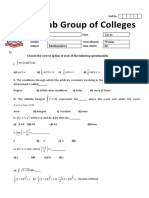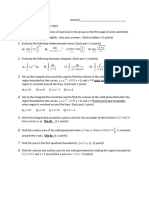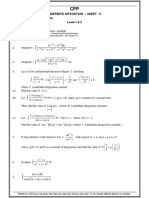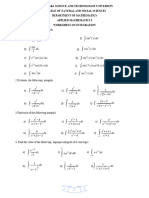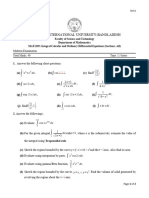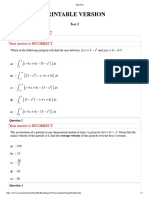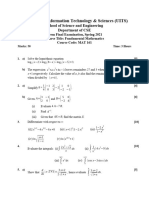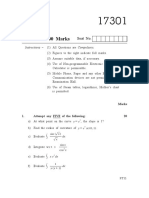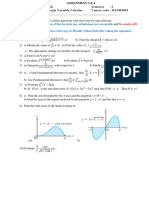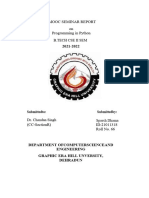Calculus 2 Worksheet 3
Calculus 2 Worksheet 3
Uploaded by
Alexander KirosCopyright:
Available Formats
Calculus 2 Worksheet 3
Calculus 2 Worksheet 3
Uploaded by
Alexander KirosOriginal Description:
Original Title
Copyright
Available Formats
Share this document
Did you find this document useful?
Is this content inappropriate?
Copyright:
Available Formats
Calculus 2 Worksheet 3
Calculus 2 Worksheet 3
Uploaded by
Alexander KirosCopyright:
Available Formats
Addis Ababa University
Worksheet on chapter 3 for Calculus II
For Computer Sc. students
2021/22
1. Check Cauchy’s MVT for the functions 𝑓(𝑥) = 𝑥 3 and 𝑔(𝑥) = arctan(𝑥) on [0, 1].
2. Find the number c which satisfy the conclusion of Cauchy mean value theorem for 𝑓 = 𝑒 𝑥
and 𝑔 = 𝑒 −𝑥 on any interval [𝑎, 𝑏].
3. Use Cauchy’s mean value theorem to show that
𝑥2
1− < cos 𝑥 ∀𝑥 ≠ 0.
2
4. Evaluate the following limits with indeterminate forms:
𝑠𝑖𝑛4𝑥
(a) lim𝑥→0
𝑡𝑎𝑛5𝑥
ln 𝑥
(b) lim𝑥→∞ 𝑥−1
(c) lim𝑥→∞ √𝑥 2 + 𝑥 − 𝑥
1
(d) lim𝑥→∞ 𝑥 𝑥
1
(e) lim𝑥→0+ cot 𝑥 − 𝑥
5. Evaluate the following improper integrals, if they converge
dx
x ln x
4 dx
a) 3 (x 3) 2
e) 3
2
2 xdx
2
b)
4 x
0 2 f) sec x dx
1 4
c) 3
dx
0 x x
g) xe x2
dx
e
dx
x
d) dx
x
1 h)
0
1
2
6 x 10
e) x
dx
x
0 e e
6. Test if the following improper integrals are convergent or divergent without
evaluating.
∞ 2
a. ∫1 𝑒 −𝑥 𝑑𝑥
𝜋
b. ∫02 tan 𝑥 𝑑𝑥
7. Find the area of the infinite region in the first quadrant between 𝑦 = 𝑒 −𝑥 and the x-
axis.
8. Find the area of the region that lies between the curves y=sec x and y=tan x from x=0
𝜋
to x=2 .
9. Find a Taylor polynomial of degree n at a for f where:
(a) 𝑓(𝑥) = 𝑒 5𝑥 , 𝑛 = 4, 𝑎 = 2
1
(b) 𝑓(𝑥) = 1−𝑥 , 𝑛 = 5, 𝑎 = 2
𝜋
(c) 𝑓(𝑥) = 𝑠𝑖𝑛𝑥, 𝑛 = 5, 𝑎 = 6
10. Find a fifth–degree Maclaurin polynomial for 𝑓(𝑥) = sin(3𝑥).
Addis Ababa University
Worksheet on chapter 3 for Calculus II
For Computer Sc. students
2021/22
11. Let f be a function that has derivatives of all orders for all real numbers. Assume
f 0 5, f 0 3, f 0 1, f 0 4.
(a) Write the third-degree Taylor polynomial for f about x = 0, and use it to approximate
f 0.2 .
(b) Write the fourth-degree Taylor polynomial for g, where g x f x 2 , about x = 0.
(Hint: Substitute x 2 in place of x in your answer to (a).)
(c) Write the third-degree Taylor polynomial for h, where h x f t dt , about x = 0.
x
(d) Let h be defined as in part (c). Given that f 1 3, either find the exact value of h 1
or explain why it cannot be determined.
You might also like
- Dokumen - Tips Latest Saudi Aramco 9com Ik Manufacturers List in Excel FormatDocument36 pagesDokumen - Tips Latest Saudi Aramco 9com Ik Manufacturers List in Excel FormatWASSIM SUNNANo ratings yet
- Floor Plan ManagerDocument14 pagesFloor Plan Managersapafj100% (1)
- User FileDocument6 pagesUser FileSateesh AgrahariNo ratings yet
- IKEA Catalogue 2012Document189 pagesIKEA Catalogue 2012nguyễn thăng vănNo ratings yet
- Ignition ScriptingDocument152 pagesIgnition Scriptingvijikesh Arunagiri0% (1)
- Vtorkol K enDocument2 pagesVtorkol K enEraNo ratings yet
- Tut 4Document3 pagesTut 4lowtzeyang12No ratings yet
- Part2 MathDocument5 pagesPart2 MathWaqar AhmadNo ratings yet
- CSE SuggestionsDocument3 pagesCSE Suggestionssheikhrafi2002bdNo ratings yet
- N.B: Answer Six Questions, Taking Three From Each SectionDocument2 pagesN.B: Answer Six Questions, Taking Three From Each SectionRakib HasanNo ratings yet
- Math 103: Final Exam Fall 2009Document5 pagesMath 103: Final Exam Fall 2009jelenicasabancicaNo ratings yet
- Chapter 4 - IntegrationDocument51 pagesChapter 4 - IntegrationWan Fakrool Wan FadzilNo ratings yet
- Exam 2 Project Portion 3Document1 pageExam 2 Project Portion 3d7rbnvmry8No ratings yet
- Tutorial 2 CalculusDocument4 pagesTutorial 2 Calculus木辛耳总No ratings yet
- Calc I Sample Final 'B'Document1 pageCalc I Sample Final 'B'gbland100% (1)
- 09 SPP IiDocument2 pages09 SPP Iiatulya2007inNo ratings yet
- S.6 Math P1 Revision QnsDocument6 pagesS.6 Math P1 Revision QnsspoweldraxlerNo ratings yet
- Department of Mathematics MAL 110 (Mathematics I) Tutorial Sheet No. 1 Taylors Theorem and Integral CalculusDocument2 pagesDepartment of Mathematics MAL 110 (Mathematics I) Tutorial Sheet No. 1 Taylors Theorem and Integral CalculusKushagra GuptaNo ratings yet
- CH - 5 WorksheetDocument2 pagesCH - 5 WorksheetFasiko AsmaroNo ratings yet
- 考古題 IIIDocument1 page考古題 IIIShellyChenNo ratings yet
- Bca 203 2022 27072022Document2 pagesBca 203 2022 27072022Nitimoy MondalNo ratings yet
- 2 Integral DefinidaDocument3 pages2 Integral DefinidaDarío HidalgoNo ratings yet
- 2011E.C Second Semester Mathematics Worksheet-Five For Grade 12Document10 pages2011E.C Second Semester Mathematics Worksheet-Five For Grade 12Firie SibihatNo ratings yet
- Revision 9709 Paper 3Document9 pagesRevision 9709 Paper 3api-25887606No ratings yet
- Exercise Topic 4 - Integration PDFDocument6 pagesExercise Topic 4 - Integration PDFNur Natasya NajwaNo ratings yet
- CHAPTER 1 IntegrationDocument16 pagesCHAPTER 1 IntegrationSaidatul FarhaniNo ratings yet
- Problem Set 10 - IntegrationDocument3 pagesProblem Set 10 - IntegrationChi LinhNo ratings yet
- Quiz 4Document16 pagesQuiz 4Kostas TampakisNo ratings yet
- Math 2 Mid Sample QuestionDocument2 pagesMath 2 Mid Sample QuestionJamiul HasanNo ratings yet
- Candidates Are Required To Give Their Answers in Their Own Words As Far As Practicable. The Figures in The Margin Indicate Full MarksDocument2 pagesCandidates Are Required To Give Their Answers in Their Own Words As Far As Practicable. The Figures in The Margin Indicate Full MarksdineshNo ratings yet
- Math 1013 (1B) REVIEW 2024Document12 pagesMath 1013 (1B) REVIEW 2024abhilakshay2002No ratings yet
- Test 2 - Fall 2016Document5 pagesTest 2 - Fall 2016mahmoodvolunteerNo ratings yet
- Unit 3 (Topics 3.1-3.6) Review - 2019Document8 pagesUnit 3 (Topics 3.1-3.6) Review - 2019Andrew ZhengNo ratings yet
- FLCD WaDocument16 pagesFLCD WaAmanjot KaurNo ratings yet
- Work Sheet - I-C2Document2 pagesWork Sheet - I-C2yacobNo ratings yet
- Khulna University: ECE DisciplineDocument2 pagesKhulna University: ECE DisciplineTI NafisNo ratings yet
- Calculus 2 Worksheet On Chapter 2 ADocument3 pagesCalculus 2 Worksheet On Chapter 2 ATadesse B. GerbabaNo ratings yet
- PROBLEMS Antiderivatives and Indefinite IntegrationDocument13 pagesPROBLEMS Antiderivatives and Indefinite IntegrationCynthia PlazaNo ratings yet
- Au Coe QP: Question Paper CodeDocument3 pagesAu Coe QP: Question Paper CodeajithNo ratings yet
- Mcs Main 2022 Mathematics Paper IDocument3 pagesMcs Main 2022 Mathematics Paper IHmingsangliana HauhnarNo ratings yet
- 2021 2022 1《math(1)》BDocument3 pages2021 2022 1《math(1)》BZhengyi GuoNo ratings yet
- Tutorial 9 (Baru06)Document6 pagesTutorial 9 (Baru06)nabilahNo ratings yet
- Mat161 (Day)Document2 pagesMat161 (Day)lockdownbd2020No ratings yet
- AM NOV-18 (Sol) (E-Next - In)Document21 pagesAM NOV-18 (Sol) (E-Next - In)Shreya ChaurasiyaNo ratings yet
- Engineering Mathematics IDocument3 pagesEngineering Mathematics INikash SubediNo ratings yet
- Screenshot 2024-03-02 at 7.37.27 AMDocument8 pagesScreenshot 2024-03-02 at 7.37.27 AMlachudhanvuNo ratings yet
- Olan MTC Seminar Paper One Questions PDFDocument5 pagesOlan MTC Seminar Paper One Questions PDFJeremiah NakibingeNo ratings yet
- Tutorial Cal 2Document3 pagesTutorial Cal 2sara johnNo ratings yet
- Integrals 1,2,3Document2 pagesIntegrals 1,2,3nbie1883No ratings yet
- Hsslive-Xii-Maths-5. CONTINUITY AND DIFFERENTIABILITY2Document8 pagesHsslive-Xii-Maths-5. CONTINUITY AND DIFFERENTIABILITY2deepakpmani2No ratings yet
- IntegrationDocument14 pagesIntegrationJonathan LeeNo ratings yet
- Maths 23-12-2023Document2 pagesMaths 23-12-2023onlyforpubg123786No ratings yet
- Exercises For Calculus 1, Chapter 2 - Differentiation: (Friday Class)Document2 pagesExercises For Calculus 1, Chapter 2 - Differentiation: (Friday Class)Duy AnhNo ratings yet
- Exam 1 ReviewDocument2 pagesExam 1 ReviewJoseph CannonNo ratings yet
- 2015 Winter Question PaperDocument5 pages2015 Winter Question PaperSummoningNo ratings yet
- MTH 2nd SDocument14 pagesMTH 2nd Spunjabcollegekwl5800No ratings yet
- Question 821817Document10 pagesQuestion 821817Kovid AggarwalNo ratings yet
- DSE Maths Module 2 2021 Past PaperDocument31 pagesDSE Maths Module 2 2021 Past PaperJoe ChanNo ratings yet
- Integration Work Sheet PDFDocument1 pageIntegration Work Sheet PDFsharon khanNo ratings yet
- Au Coe QP: Question Paper CodeDocument3 pagesAu Coe QP: Question Paper CodePraveen ManoharanNo ratings yet
- SM 025 - INTEGRATION SoalanDocument9 pagesSM 025 - INTEGRATION SoalansharuNo ratings yet
- Single Variable Calculus Assignment-3 4Document1 pageSingle Variable Calculus Assignment-3 4PregathiNo ratings yet
- Integration I HL MathDocument8 pagesIntegration I HL MathRonald McdonaldNo ratings yet
- On the Tangent Space to the Space of Algebraic Cycles on a Smooth Algebraic VarietyFrom EverandOn the Tangent Space to the Space of Algebraic Cycles on a Smooth Algebraic VarietyNo ratings yet
- Factoring and Algebra - A Selection of Classic Mathematical Articles Containing Examples and Exercises on the Subject of Algebra (Mathematics Series)From EverandFactoring and Algebra - A Selection of Classic Mathematical Articles Containing Examples and Exercises on the Subject of Algebra (Mathematics Series)No ratings yet
- Richemont Securities SA - Richemont Annual General Meeting Updated Voting InstructionsDocument6 pagesRichemont Securities SA - Richemont Annual General Meeting Updated Voting InstructionsD_E_V_ZNo ratings yet
- BRO Home Appliances enDocument11 pagesBRO Home Appliances enKhaled Sid Ahmed AbderahimNo ratings yet
- Mooc ReportDocument16 pagesMooc ReportSparsh DhamaNo ratings yet
- Case Analysis On Jayanta Kumar Das Vs State of OdishaDocument13 pagesCase Analysis On Jayanta Kumar Das Vs State of OdishaAditya DwivediNo ratings yet
- ViatorCheck PDFDocument23 pagesViatorCheck PDFazitaggNo ratings yet
- Structures - Iii: Earthquake Behavior of BuildingsDocument24 pagesStructures - Iii: Earthquake Behavior of Buildingsabhivyakti kushwahaNo ratings yet
- Conjug4 Conjugacoes PortugueseDocument5 pagesConjug4 Conjugacoes PortugueseKareyNo ratings yet
- FDocument37 pagesFMartial SOMENo ratings yet
- ch11 Human Endocrine System Vanders Human Physiology 15e Chap011Document38 pagesch11 Human Endocrine System Vanders Human Physiology 15e Chap011sueda123eybNo ratings yet
- Why Do I See - Martian Source - Logs in The Messages File - Red Hat Customer PortalDocument8 pagesWhy Do I See - Martian Source - Logs in The Messages File - Red Hat Customer PortalManish TiwariNo ratings yet
- CDATA-XPON ONU - (C+ BOSA) - FD511G-X-F690 (1GE) Datasheet-V3.0Document4 pagesCDATA-XPON ONU - (C+ BOSA) - FD511G-X-F690 (1GE) Datasheet-V3.0fabi1988lindaNo ratings yet
- Unit 3 - Multiterminal DC SystemDocument21 pagesUnit 3 - Multiterminal DC Systemkarthik83% (6)
- Chapter 0. Prerequisites 0.3: Sum and Product Notation: Slides (Google Drive) Video (Youtube)Document5 pagesChapter 0. Prerequisites 0.3: Sum and Product Notation: Slides (Google Drive) Video (Youtube)HMXNo ratings yet
- Daycounter Inc - Snubber Circuit Design CalculatorsDocument5 pagesDaycounter Inc - Snubber Circuit Design CalculatorsLaercio Marques100% (1)
- BQ MAGAZINE Jan 2016Document43 pagesBQ MAGAZINE Jan 2016mohamed ibrahimNo ratings yet
- Research Methodology Project-1Document19 pagesResearch Methodology Project-1sss0% (2)
- DvdavkjkDocument82 pagesDvdavkjkNajeebuddin AhmedNo ratings yet
- Machine Profiles: D10R Track-Type TractorsDocument5 pagesMachine Profiles: D10R Track-Type TractorsJavier Pagan TorresNo ratings yet
- CityU Acct 23/24 Study PlanDocument1 pageCityU Acct 23/24 Study PlanCHUN HEI LUKNo ratings yet
- KKN - Mine Warfare OperationsDocument3 pagesKKN - Mine Warfare OperationsMegat AshlanNo ratings yet
- Early Civilizations in China: Powerpoint By: Esther LeeDocument17 pagesEarly Civilizations in China: Powerpoint By: Esther LeeLee EstherNo ratings yet
- Wepik Revolutionizing Road Infrastructure A Comprehensive Overview of Road Civil Engineering 20231029040210dc0iDocument10 pagesWepik Revolutionizing Road Infrastructure A Comprehensive Overview of Road Civil Engineering 20231029040210dc0isameerkant089No ratings yet
- 004 Profitability of Islamic BankDocument18 pages004 Profitability of Islamic BanksaraNo ratings yet
- Wooden Mallet Plans - WoodArchivistDocument4 pagesWooden Mallet Plans - WoodArchivistErics100% (1)







